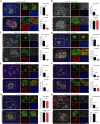Validating expression of beta cell maturation-associated genes in human pancreas development
- PMID: 36846594
- PMCID: PMC9945361
- DOI: 10.3389/fcell.2023.1103719
Validating expression of beta cell maturation-associated genes in human pancreas development
Abstract
The identification of genes associated with human pancreatic beta cell maturation could stimulate a better understanding of normal human islet development and function, be informative for improving stem cell-derived islet (SC-islet) differentiation, and facilitate the sorting of more mature beta cells from a pool of differentiated cells. While several candidate factors to mark beta cell maturation have been identified, much of the data supporting these markers come from animal models or differentiated SC-islets. One such marker is Urocortin-3 (UCN3). In this study, we provide evidence that UCN3 is expressed in human fetal islets well before the acquisition of functional maturation. When SC-islets expressing significant levels of UCN3 were generated, the cells did not exhibit glucose-stimulated insulin secretion, indicating that UCN3 expression is not correlated with functional maturation in these cells. We utilized our tissue bank and SC-islet resources to test an array of other candidate maturation-associated genes, and identified CHGB, G6PC2, FAM159B, GLUT1, IAPP and ENTPD3 as markers with expression patterns that correlate developmentally with the onset of functional maturation in human beta cells. We also find that human beta cell expression of ERO1LB, HDAC9, KLF9, and ZNT8 does not change between fetal and adult stages.
Keywords: development; human; islets; maturation; stem cells.
Copyright © 2023 Tremmel, Mikat, Gupta, Mitchell, Curran, Menadue, Odorico and Sackett.
Conflict of interest statement
The authors declare that the research was conducted in the absence of any commercial or financial relationships that could be construed as a potential conflict of interest.
Figures






Similar articles
-
The Black Book of Psychotropic Dosing and Monitoring.Psychopharmacol Bull. 2024 Jul 8;54(3):8-59. Psychopharmacol Bull. 2024. PMID: 38993656 Free PMC article. Review.
-
RFX3 is essential for the generation of functional human pancreatic islets from stem cells.Diabetologia. 2025 Jul;68(7):1476-1491. doi: 10.1007/s00125-025-06424-4. Epub 2025 Apr 23. Diabetologia. 2025. PMID: 40263183 Free PMC article.
-
Can a Liquid Biopsy Detect Circulating Tumor DNA With Low-passage Whole-genome Sequencing in Patients With a Sarcoma? A Pilot Evaluation.Clin Orthop Relat Res. 2025 Jan 1;483(1):39-48. doi: 10.1097/CORR.0000000000003161. Epub 2024 Jun 21. Clin Orthop Relat Res. 2025. PMID: 38905450
-
Sexual Harassment and Prevention Training.2024 Mar 29. In: StatPearls [Internet]. Treasure Island (FL): StatPearls Publishing; 2025 Jan–. 2024 Mar 29. In: StatPearls [Internet]. Treasure Island (FL): StatPearls Publishing; 2025 Jan–. PMID: 36508513 Free Books & Documents.
-
Antidepressants for pain management in adults with chronic pain: a network meta-analysis.Health Technol Assess. 2024 Oct;28(62):1-155. doi: 10.3310/MKRT2948. Health Technol Assess. 2024. PMID: 39367772 Free PMC article.
Cited by
-
Development, regeneration, and physiological expansion of functional β-cells: Cellular sources and regulators.Front Cell Dev Biol. 2024 Jul 9;12:1424278. doi: 10.3389/fcell.2024.1424278. eCollection 2024. Front Cell Dev Biol. 2024. PMID: 39045459 Free PMC article. Review.
-
Integrating population genetics, stem cell biology and cellular genomics to study complex human diseases.Nat Genet. 2024 May;56(5):758-766. doi: 10.1038/s41588-024-01731-9. Epub 2024 May 13. Nat Genet. 2024. PMID: 38741017
-
Expression of FAM159B in Humans, Rats, and Mice: A Cross-species Examination.J Histochem Cytochem. 2024 Jul;72(7):467-487. doi: 10.1369/00221554241262368. Epub 2024 Jun 22. J Histochem Cytochem. 2024. PMID: 38907656 Free PMC article.
-
Cell identity dynamics and insight into insulin secretagogues when employing stem cell-derived islets for disease modeling.Front Bioeng Biotechnol. 2024 Jun 12;12:1392575. doi: 10.3389/fbioe.2024.1392575. eCollection 2024. Front Bioeng Biotechnol. 2024. PMID: 38933536 Free PMC article.
-
Unveiling cell subpopulations in T1D mouse islets using single-cell RNA sequencing.Am J Physiol Endocrinol Metab. 2024 May 1;326(5):E723-E734. doi: 10.1152/ajpendo.00323.2023. Epub 2024 Mar 20. Am J Physiol Endocrinol Metab. 2024. PMID: 38506753 Free PMC article.
References
LinkOut - more resources
Full Text Sources
Miscellaneous

